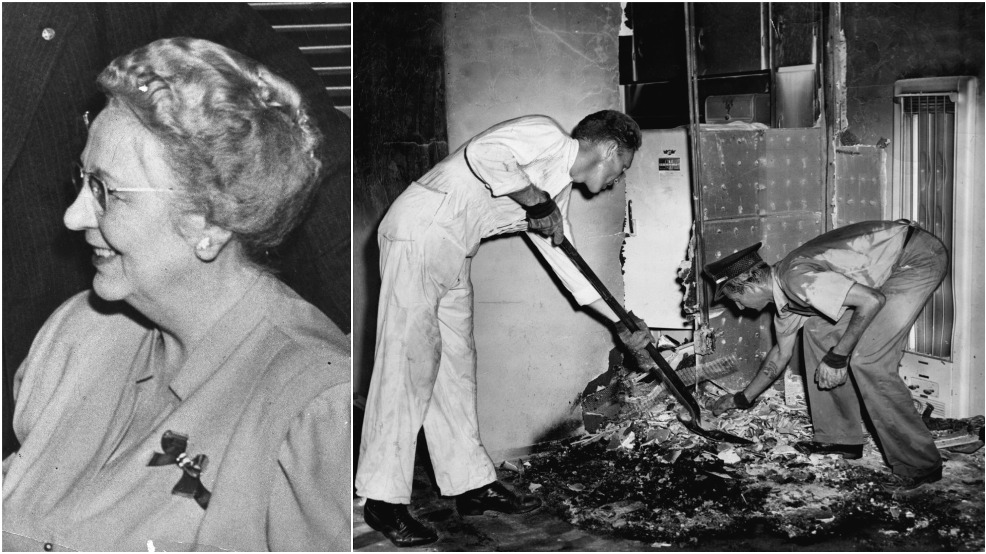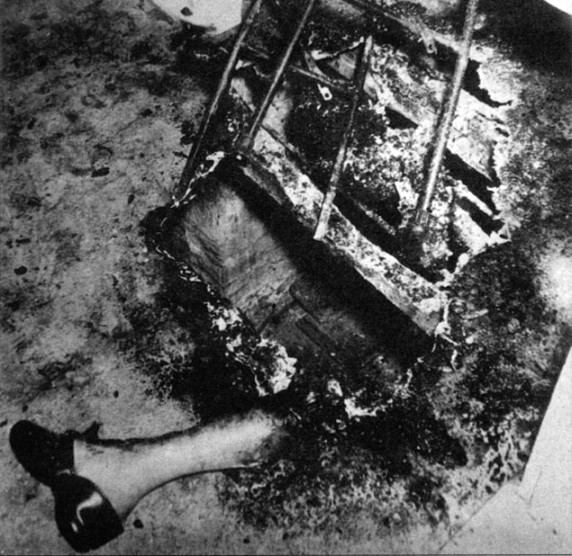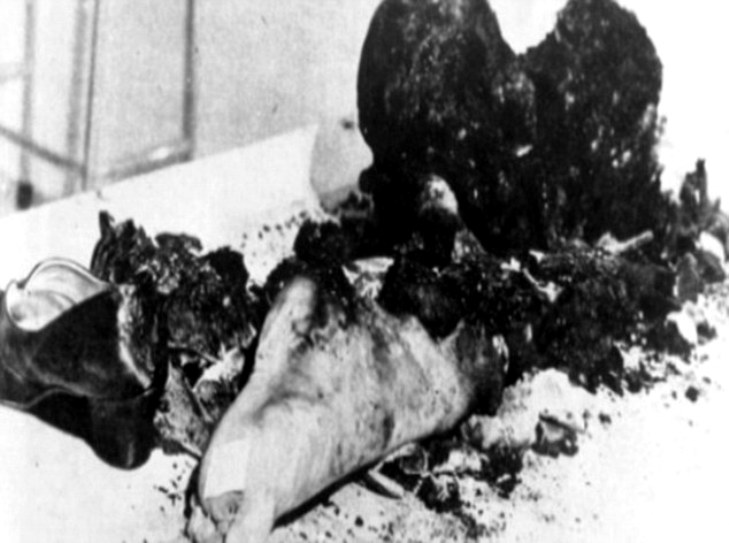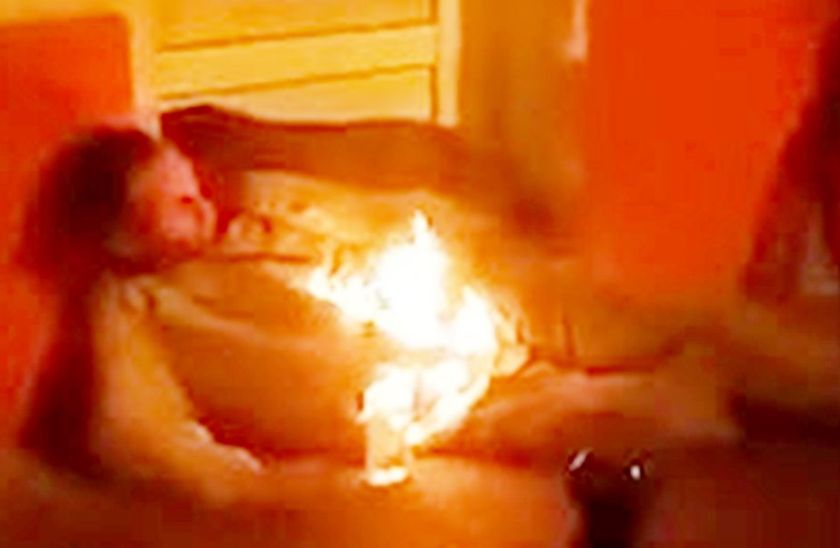
On this month's Morbidly Fascinating Page:
Spontaneous Human Combustion: is it real or not?
In the Morbidly Fascinating Archives
Haunted White House
Deep Sea Creatures
Chimera
Lizzie Borden
The most famous case: Mary Hardy Reeser (March 8, 1884 – July 2, 1951) in St. Petersburg, Florida.


Before sinking into the overstuffed easy chair in the middle of her St. Petersburg apartment, a widow named Mary Hardy Reeser slipped into a nightgown and popped two sleeping pills. Hot summer air drifted through the open windows.
It was around 9 p.m. on July 1, 1951. Reeser’s only son, Dr. Richard Reeser Jr., had just kissed her goodbye after a visit. She was alone for the night and decided to enjoy a cigarette before bed.
Reeser, 67, would not be seen alive again. When the landlady, Pansy Carpenter, tried to deliver a telegram the next morning, the door to Reeser’s small apartment on 1200 Cherry Street Northeast was warm and the handle too hot to touch. Inside the charred walls, embers still crackled.
Firefighters burst into a soot and smoke-filled apartment. Reeser was gone, and only a pile of black ashes remained.
Amid the rubble, police found coil springs from the chair and part of Reeser’s backbone. Her left foot sat in the pile, still wearing a black silk slipper. Her skull, reports say, had “shrunken to the size of a cup.”
Firefighters found evidence of extreme heat. Bare candle wicks towered above puddles of melted wax. Smudges of smoke had stained the tops of the walls. Warped electric switches lined the room.
Lower down, the walls were clean and the electric switches looked normal. Reeser’s newspapers sat untouched. The sheets on her bed were still white.
Reeser’s story is perhaps the strangest unsolved mystery in Tampa Bay history. The case has been documented in magazine articles, documentaries and books. But questions remain.
How could a woman go up in flames without the rest of the room burning? What could have killed Mary Reeser?
St. Petersburg Police Chief J.R. Reichart drafted a letter. "Dear Mr. (J. Edgar) Hoover,” he wrote. “This fire is too puzzling for the small-town force to handle."
Her daughter-in-law said "The cigarette dropped to her lap. Her fat was the fuel that kept her burning. The floor was cement, and the chair was by itself. There was nothing around her to burn."
The FBI eventually declared that Reeser had been incinerated by the wick effect. As she was a known user of sleeping pills, they hypothesized that she had fallen unconscious while smoking and set fire to her nightclothes. "Once the body starts to burn," the FBI wrote in its report, "there is enough fat and other inflammable substances to permit varying amounts of destruction to take place. Sometimes this destruction by burning will proceed to a degree which results in almost complete combustion of the body."
Unnamed woman on July 30, 1937 in Norfolk Broads, England

On July 30, 1937, a woman at England's Norfolk Broads was engulfed by terrible blue flames and was nothing but a mound of ash in a matter of a few horrifying moments.
Dr. D. J. Gee, a lecturer in forensic medicine at the University of Leeds, England, wrote of a case of SHC for the journal Medicine, Science and the Law (5:37–8, January 1965). According to Gee, the victim was a slim, 85-year-old woman who lived with her son and daughter-in-law in a ground-floor apartment. Her family had left the apartment by 9:30 A.M. on the day she died. Neighbors had discovered smoke issuing from a kitchen window and found the smoldering remains of a human body on the hearth.
When Gee visited the apartment two hours later, he noticed that the room was exceedingly warm and the ceiling felt hot. The paintwork was blistered and the walls and furnishings begrimed by soot. Only a part of the wooden edge of the hearth was burned, and a small section, approximately one foot in diameter, of the floor was damaged. The rug had not been burned, but it was greasy with tiny fragments of fat. A tea towel lying near where the body had been found was barely singed, and a large pile of dry firewood remained unaffected.
Spontaneous human combustion or had the woman simply fallen into the fire?
See more HERE
Danny VanZandt in February 2013 in Muldow, Oklahoma


Family members said they found the burned remains of 65-year-old Danny VanZandt in his home near Muldrow, in eastern Oklahoma, near the Arkansas border.
The only structural damage was to the kitchen floor where VanZandt lay, said Sequoyah County Sheriff Ron Lockhart.
"This house is intact. There is a stove and ice box within 3 feet from where the body's burning and the handles are not melted," he told The Tulsa World. "You could pour gasoline on somebody and he wouldn't be as badly incinerated."
Lockart, a former arson investigator, said the way the body burned was inconsistent with a lighted cigarette being dropped.
"This is a case that I've never seen before," Lockhart said. "I think there's only about 200 cases of spontaneous human combustion worldwide, and I'm not saying that this has happened, I'm just saying that we haven't ruled it out."
See more HERE
John Nolan, September 17, 2017 on a North London Street

70-year-old John Nolan was walking down a London street when he caught fire and died. Now the police are appealing to the public for help to solve the mystery of Nolan's death, because they still cannot figure out why the hell he suddenly erupted into flames.
According to the Independent, firefighters responded to a report of "a man ablaze" on September 17th, and were met by a scene of bystanders trying to put out the fire. Nolan, a retired construction worker, was rushed to the hospital but ended up dying of severe burns.
Is this a case of spontaneous human combustion? If so, it wouldn't be the first time the phenomenon was documented. A study published in the Journal of Forensic Medicine looked at cases of spontaneous human combustion in the past three centuries, and concluded that each of the cases had three things in common: the body is destroyed but "the immediate surroundings are left almost intact"; "there is often no visible source of heat that might have started the fire"; and certain body parts are completely preserved, while others are "reduced to a state of ashes."
Or had he simply set himself on fire with a cigarette?
See more HERE
Here is an instance where the coroner actually ruled death as spontaneous human combustion. An Irish coroner ruled death to be spontaneous combustion for Michael Faherty, 76, who died at his home in Galway on 22 December 2010

West Galway coroner Dr Ciaran McLoughlin (above)
West Galway coroner Dr Ciaran McLoughlin said it was the first time in 25 years of investigating deaths that he had recorded such a verdict.
Michael Faherty, 76, died at his home in Galway on 22 December 2010.
Deaths attributed by some to "spontaneous combustion" occur when a living human body is burned without an apparent external source of ignition.
Typically police or fire investigators find burned corpses but no burned furniture.
An inquest in Galway on Thursday heard how investigators had been baffled as to the cause of Mr Faherty's death at his home at Clareview Park, Ballybane.
Forensic experts found that a fire in the fireplace of the sitting room where the badly burnt body was found, had not been the cause of the blaze that killed Mr Faherty.
The court was told that no trace of an accelerant had been found and there had been nothing to suggest foul play.
The court heard Mr Faherty had been found lying on his back with his head closest to an open fireplace.
The fire had been confined to the sitting room. The only damage was to the body, which was totally burnt, the ceiling above him and the floor underneath him.
See more HERE
IS SPONTANEOUS HUMAN COMBUSTION A REAL THING?

Spontaneous human combustion is a mystery with an impressive literary pedigree. Herman Melville and Nikolay Gogol used it to dispatch characters in their novels Redburn and Dead Souls, respectively. But the most notorious case in fiction is Bleak House by Charles Dickens, where the sleazy alcoholic junk merchant Mr. Krook ends up as a heap of ashes on the floor and “a dark, greasy coating on the walls and ceiling.” In the preface to the book edition of Bleak House, written after the novel had already been published in serial form, Dickens defended his use of spontaneous combustion against accusations of implausibility, citing several famous cases and the judgments of eminent medical doctors that such a thing was indeed possible. “I shall not abandon the facts,” he concludes with typical Dickensian panache, “until there shall have been a considerable Spontaneous Combustion of the testimony on which human occurrences are usually received.”
Descriptions of spontaneous human combustion date back to the 17th century, with a large number of cases recorded in the 19th century and a handful in the 20th and 21st centuries. Altogether, there are a few hundred recorded possible cases. Although the scientific support for spontaneous human combustion was weaker than Dickens stated, it was a widely discussed phenomenon in his time. The public largely accepted it as a reality on moral grounds. The victims were often alcoholic and overweight, and more were female than male, so there was a general perception that it was a kind of retribution for a debauched lifestyle. This idea was reinforced by lurid newspaper accounts of suspected cases. It made intuitive sense, after all, that a body saturated with a flammable substance—alcohol—would become flammable.
Now for the important question: Is spontaneous human combustion real? Is the possibility of suddenly bursting into flames one more thing for us all to worry about?
The answer is almost certainly no. None of the proposed scientific explanations for how a body would spontaneously burst into flames have held up to scrutiny. Some of the early proposed mechanisms rely on outdated medical ideas, such as the notion that an ignition could be the result of an imbalance of the bodily humors. The Victorian explanation that alcohol rendered the body flammable doesn’t work either, seeing that the concentrations of alcohol in even the most intoxicated people are much too low and that an external source of ignition would be required.
In the 20th century, forensic scientists noticed the “wick effect” in which clothing worn by a victim can soak up melted fat, acting like the wick in a candle and creating conditions for a body to smolder for an extended period of time. Experiments have shown that this effect can produce many of the unusual characteristics associated with spontaneous human combustion, such as the complete or nearly complete incineration of the body and the lack of fire damage to the victim’s surroundings. The likely explanation for suspected cases of spontaneous human combustion, then, is that there is an external source of ignition—a match, a cigarette, an electrical spark—that sets off the wick effect, but the evidence of it is destroyed by the fire. Although alcohol doesn’t make the body more flammable, severe inebriation or other forms of impairment may be a factor in some of these deaths since the victim may be unable to react to a slowly developing fire.